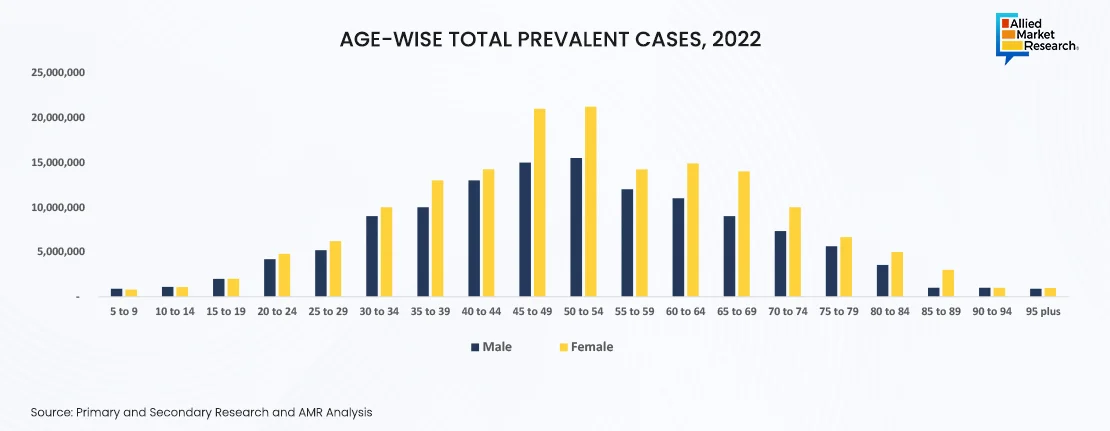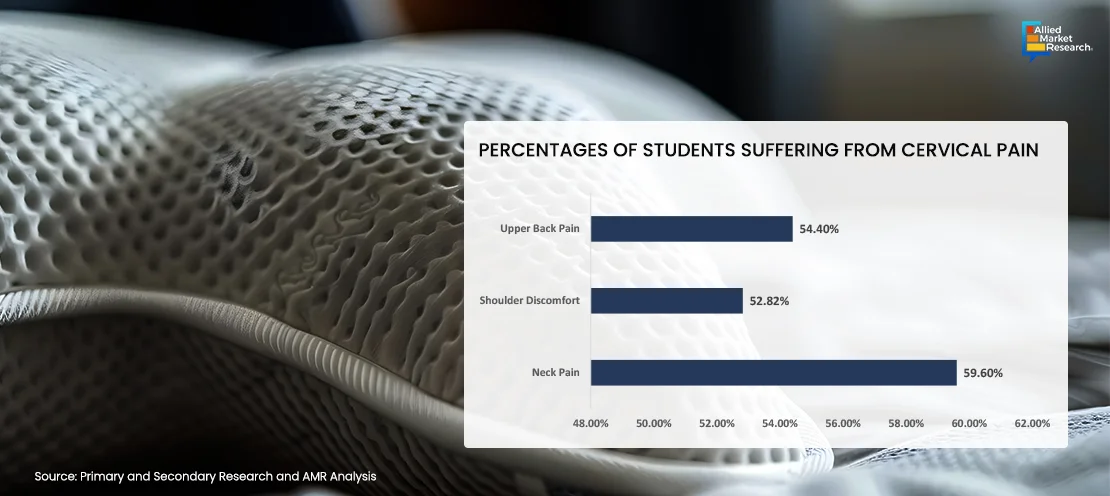Advanced Cervical Pillows Improving Sleep and Health

Designed to correct the positioning of the head and neck, cervical pillow is a curved-shaped pillow that improves posture while sleeping. Cervical support pillows have gained prominence due to rise in awareness of spinal health and the increase in demand for natural, non-invasive solutions. In addition, there has been a significant shift in the mindset of consumers toward an impact on well-being of spinal health and overall physical comfort. In 2022, cervical pain affected more females than males globally, with 166.0 million cases among women compared to 122.7 million among men. Women experienced a higher burden of years lived with disability (YLDs) owing to neck pain in different age groups. In addition, the prevalence peaked in the 50–54 age group and declined with advancing age. Thus, the pattern highlights the significant impact of cervical pain, particularly among females and older individuals.
Role of Cervical Pillows in Alleviating Discomfort from Smartphone Usage
In addition, neck and back aches are common issues among smartphone users, affecting a wide range of individuals globally. Head and neck problems, particularly prevalent among university students, have a negative impact on cervical pain which ranges between 17.3% to 67.8% of users. Research indicates that 59.6% of students suffer from neck pain, 52.82% experience shoulder discomfort, and 54.4% report upper back pain globally. The static positioning of upper extremities during smartphone uses for activities such as messaging, surfing, and gaming contributes to discomfort, often leading to reduced motor ability. Smartphone users frequently adopt a forwardly flexed head and neck posture, which increases upper cervical and neck flexion angles over time.

Thus, understanding these prevalent symptoms among smartphone users greatly benefits the cervical pillow market, as consumers seek solutions to alleviate discomfort and prioritize spinal health and posture. Cervical pillows, specifically designed to support the neck and promote proper spinal alignment while sleeping, offer a viable solution to address cervical pain issues. As awareness of the link between smartphone usage and neck pain grows, the demand for cervical pillows is expected to rise, driven by consumers prioritizing their spinal health and seeking non-invasive relief options.

Moreover, research has found that cervical pillows are effective in reducing neck pain and improving sleep quality. A 2022 study published in the Journal of Physical Therapy Science found that people with neck pain who used a cervical pillow for 4 weeks reported significant improvements in pain and sleep quality.
Cervical pillows are made up of diverse types of materials such as foam, back wheat, and feathers. They offer soft support to pinched nerves and cervical curves. These pillows are commonly used for the prevention of cervical spondylosis. Cervical spondylosis is majorly caused due to bad body posture and poor sleeping posture. These pillows are available in different shapes and designs that are suitable for different people who have different sleeping patterns such as side sleepers and back sleepers.
Applications of Cervical Pillow
Cervical pillows are used to support the neck area after injuries such as car accidents, sports injuries, and whiplash. Serious injuries damage the upper backbone and neck bone nerves resulting in long-term consequences, cervical pillows offer soft support to nerves and help to reduce the pains of patients. Many wrestlers use these pillows for treatment of injuries that occur while wrestling, as cervical pillows help to recover soon. Nowadays, cervical spondylosis is quite common in the geriatric population, it occurs due to the erosion of the spinal cord, which causes chronic pain and stiffness in the neck. They help to maintain cervical curves while sleeping and offers proper relaxation to muscles and regaining of proper posture. Many sportspersons and gymnasts who suffer from sports injuries use cervical pillows for rapid healing. The rise in adoption of these pillows after different accidental and sports injuries is a major factor that boosts the growth of the global cervical pillow industry.
Cervical pillows are commonly used in regular physiotherapy treatment for the long-term effects of injuries such as broken collar & neck bones, internal tissue damage of the neck, upper back fractures, and severe shoulder pains. With a rapidly changing urban lifestyle, cervical pillows have proven to be an effortless way of dealing with neck misalignment that is caused by prolonged exposure to smartphones and computer screens. The rise in dependency on these gadgets has become a leading factor in acute cases of spondylosis and to curb this problem, cervical pillows are prescribed by medical professionals or doctors as an efficient and simple preventive tool. The rise in use of cervical pillows in routine life improves the overall cervical health, reducing pain and discomfort in the neck region.
Innovations in the Cervical Pillow Market
The cervical pillow market has shown significant growth in the last few years, with rapid inclination in the application of cervical pillows for the treatment of diverse types of injuries. They have emerged as a domestic medical aid. Wide adoption of these pillows among individuals with cervical pain along with innovation in cervical pillows by key players have helped to enhance the overall health of individuals suffering from cervical issues.
Innovations in the cervical pillow market have been pivotal in driving market growth by addressing diverse consumer needs and enhancing therapeutic efficacy. Key innovations include advanced materials such as memory foam and gel-infused designs, offering personalized support and temperature regulation for improved comfort. Adjustable features, such as height and firmness settings, cater to individual preferences and provide tailored support for various sleep positions. Ergonomic contours and specialized shapes, such as orthopedic designs and contoured edges, promote proper spinal alignment and alleviate pressure points, reducing neck pain and discomfort. Furthermore, technological advancements, such as smart sensors and integrated massage functions, add value by offering additional relaxation and therapeutic benefits. These innovations enhance user experience and expand the market by attracting new consumers seeking effective solutions for cervical pain relief and improved sleep quality.
Future Outlook of the Cervical Pillow Industry
The cervical pillow market continues to grow as manufacturers strive to innovate and meet evolving consumer demands for better spinal health and comfort. Key players invest in the innovation of products and engage with research & development processes to offer improvised and innovative products to cater to the demand of its consumers and to compete with competitors and rival products. For instance, key players such as Core Products International, Therapeutica, Tempur-Pedic, and Chattanooga Group have introduced diverse types of these pillows such as pancake cervical pillows, cylindrical cervical pillows, tempur-pedic cervical pillows, and d-core cervical pillows. These cervical pillows are height adjustable and applicable for diverse types of cervical disorders, they help in rapid relief and better spine alignment. Innovation in cervical pillows serves the purpose of alleviating cervical discomfort.
The use of these pillows is on the rise as awareness of spinal health has increased over the years. Various research has indicated the effectiveness of cervical pillow in reducing neck pain and improving sleep quality. These pillows, made of various materials such as foam and feathers, offer soft support and are crucial in preventing cervical spondylosis, which is caused by poor posture. Moreover, innovations in the market, including advanced materials and ergonomic designs, address diverse needs and drive growth by attracting consumers seeking relief from neck pain. In addition, cervical pillows are instrumental in injury recovery, aiding in the healing process for sports injuries and cervical spondylosis. The surge in demand for cervical pillow in routine use, especially in urban settings to counteract the effects of prolonged gadget use has increased in recent years, which is anticipated to boost market expansion.



